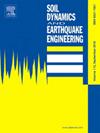Dynamic response and failure mechanisms of soil–subway station structure systems considering liquefied soil layer distribution
IF 4.2
2区 工程技术
Q1 ENGINEERING, GEOLOGICAL
引用次数: 0
Abstract
Underground structures may be buried in liquefiable sites, which can cause complex seismic response mechanisms depending on the extent and location of the liquefiable soil layer. This study investigates the seismic response of multi-story underground structures in sites with varying distributions of liquified soil employing an advanced three-dimensional nonlinear finite element model. The results indicate that the extent and location of liquefied soil layers affect the seismic response characteristics of underground structures and the distribution of their damage. When the lower story of the subway station is buried in liquefied interlayer site, the structure experiences the most serious damage. When the structure is located within a liquefiable interlayer site, the earthquake ground motion will induce greater inter-story deformation in the structure, resulting in larger structural residual displacement. When all or part of the underground structure is buried in the liquefiable soil layer, the structural failure mode should be assessed to ensure that the underground rail transit can quickly restore functionality after an earthquake. Meanwhile, permeability effects of liquefiable soil have a significant impact on the dynamic response of subway station in the liquefiable site.
考虑液化土层分布的土-地铁车站结构体系动力响应及破坏机制
地下结构可能埋在可液化土层中,根据可液化土层的范围和位置,可引起复杂的地震反应机制。本文采用先进的三维非线性有限元模型,研究了不同液化土分布条件下多层地下结构的地震反应。结果表明,液化土层的范围和位置影响地下结构的地震反应特征及其损伤分布。当地铁车站下层埋于液化层间场地时,结构受到的破坏最为严重。当结构位于可液化层间场地时,地震地震动会引起结构较大的层间变形,从而导致较大的结构残余位移。当地下结构全部或部分埋于可液化土层中时,应对结构破坏模式进行评估,以保证地下轨道交通在地震后能够快速恢复功能。同时,可液化土的渗透效应对可液化场地地铁车站的动力响应有显著影响。
本文章由计算机程序翻译,如有差异,请以英文原文为准。
求助全文
约1分钟内获得全文
求助全文
来源期刊

Soil Dynamics and Earthquake Engineering
工程技术-地球科学综合
CiteScore
7.50
自引率
15.00%
发文量
446
审稿时长
8 months
期刊介绍:
The journal aims to encourage and enhance the role of mechanics and other disciplines as they relate to earthquake engineering by providing opportunities for the publication of the work of applied mathematicians, engineers and other applied scientists involved in solving problems closely related to the field of earthquake engineering and geotechnical earthquake engineering.
Emphasis is placed on new concepts and techniques, but case histories will also be published if they enhance the presentation and understanding of new technical concepts.
 求助内容:
求助内容: 应助结果提醒方式:
应助结果提醒方式:


